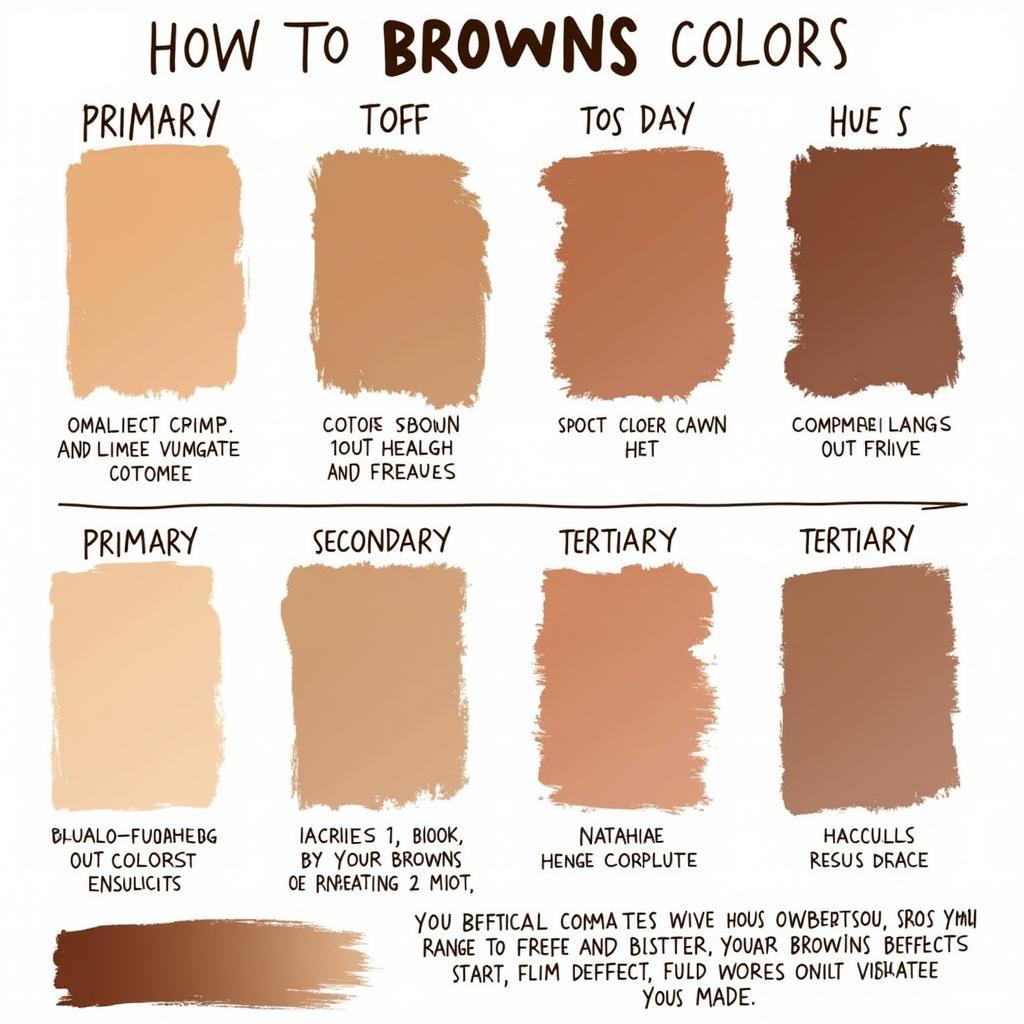A Brown Food Coloring Mixing Chart is your secret weapon to achieving the perfect shade of brown for all your culinary creations. Whether you’re aiming for a rich chocolate brown or a delicate tan, understanding how to mix colors effectively can transform your baking and decorating projects. Dive into the world of brown food coloring and unlock the potential of this versatile hue.  Brown Food Coloring Mixing Chart with Primary Colors
Brown Food Coloring Mixing Chart with Primary Colors
Decoding the Brown Food Coloring Mixing Chart
Creating brown food coloring doesn’t have to be a guessing game. A brown food coloring mixing chart provides a visual guide to help you understand the relationship between primary colors and the resulting brown hues. By combining different ratios of red, yellow, and blue, you can achieve a wide spectrum of browns, from warm, earthy tones to cool, chocolatey shades. What’s more, a mixing chart allows for precise color matching, ensuring consistent results every time.
Why is a Brown Food Coloring Mixing Chart Essential?
Precision and consistency are key in baking and decorating. Imagine trying to recreate a beloved family recipe only to find the color is off. A brown powder food coloring mixing chart removes the guesswork and empowers you to achieve the exact shade of brown you desire. This is particularly important for professional bakers and decorators who need to maintain consistent branding and aesthetics.
Creating Brown with Primary Colors
The foundation of a brown food coloring mixing chart lies in the primary colors: red, yellow, and blue. Combining these colors in varying proportions will yield different shades of brown.
- More Red: Adding more red to your mix will result in a warmer, reddish-brown. Think of the color of a terracotta pot or a rusty hue.
- More Yellow: A higher proportion of yellow will create a lighter, more golden brown, reminiscent of caramel or honey.
- More Blue: Blue will deepen the brown and add a cooler undertone, creating shades closer to dark chocolate or espresso.
Beyond the Basics: Exploring Secondary Colors and Beyond
While primary colors form the basis of brown, experimenting with secondary colors (orange, green, and violet) can unlock an even wider range of brown nuances.
- Orange (Red + Yellow): Adding orange to your mix will create a warm, earthy brown.
- Green (Blue + Yellow): Green can add depth and complexity to your brown, creating olive or khaki hues.
- Violet (Red + Blue): Violet can deepen and cool down your brown, creating shades with a purplish undertone.
“Using a brown food coloring mixing chart isn’t just about following a recipe; it’s about understanding color theory and using it to express your creativity,” says renowned pastry chef, Amelia Dubois. “It’s like having an artist’s palette at your fingertips.”
 Brown Food Coloring Mixing Chart with Color Variations
Brown Food Coloring Mixing Chart with Color Variations
Tips for Using a Brown Food Coloring Mixing Chart
- Start with small amounts of color and gradually add more until you reach the desired shade.
- Keep track of your color ratios so you can easily replicate your results.
- Experiment with different brands of food coloring, as their concentrations can vary.
- Don’t be afraid to step outside the lines and create your own unique brown blends.
Conclusion
A brown food coloring mixing chart is an invaluable tool for anyone who works with food coloring. It offers precision, consistency, and the ability to create a vast array of brown hues, transforming boring food into edible works of art. By understanding the principles of color mixing, you can take your culinary creations to the next level.
FAQ
- Can I use a brown food coloring mixing chart with gel food coloring?
- What’s the difference between liquid and powder food coloring when mixing brown?
- How do I make a dark chocolate brown color using a mixing chart?
- Can I mix different brands of food coloring together?
- What’s the best way to store mixed food coloring?
- How can I achieve a natural-looking light brown using a food coloring mixing chart?
- What are some common mistakes to avoid when using a brown food coloring mixing chart?
Other topics you might be interested in include food dye color mixing chart.
For support, please contact us at Phone Number: 02437655121, Email: minacones@gmail.com or visit us at 3PGH+8R9, ĐT70A, thôn Trung, Bắc Từ Liêm, Hà Nội, Việt Nam. We have a 24/7 customer service team.